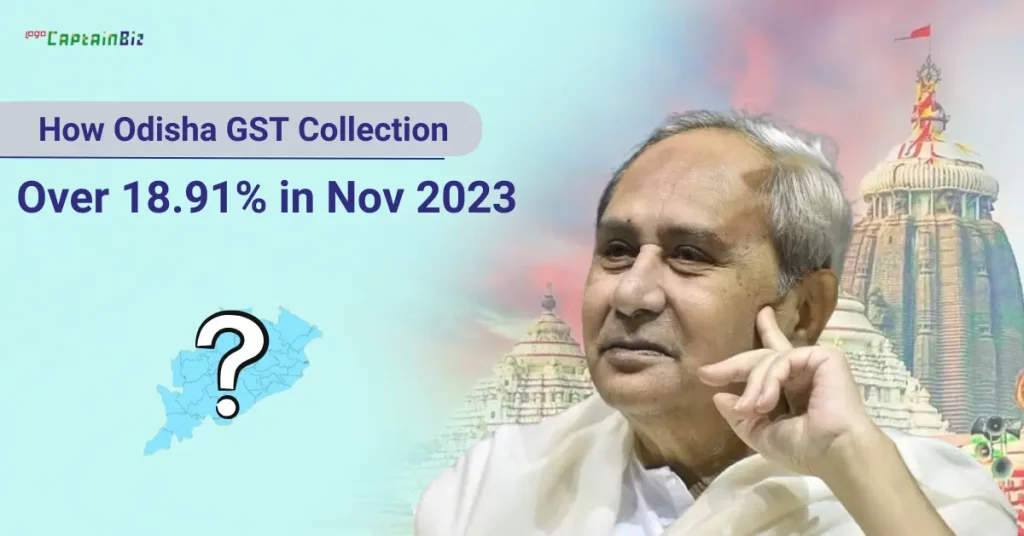The topic we’re exploring today is the remarkable increase in GST (Goods and Services Tax) collection in Odisha during November 2023. It’s quite fascinating as the growth rate surged beyond 18.91%. This surge in tax collection has caught the attention of many, prompting us to delve deeper into the reasons behind this impressive accomplishment. Let’s take a closer look at what led to this amazing growth and what it means for the state of Odisha.
Understanding GST
GST, or Goods and Services Tax, is a unified tax on goods and services in India, introduced to simplify the tax system. Before GST, there were multiple taxes like VAT, excise duty, and service tax, making compliance complex for businesses. GST aims to streamline this by consolidating these taxes into a single tax, reducing the burden on businesses. It helps businesses by making tax calculations simpler and reducing the number of taxes they need to pay, thus improving ease of doing business.
One of the primary reasons why GST matters is because it simplifies the taxation system. Before GST, there were multiple layers of taxes imposed by both the central and state governments, leading to a complex tax structure. GST has unified these taxes into a single tax system, making compliance easier for businesses and reducing the tax burden on consumers.
Another important aspect of GST is its role in promoting economic growth. By eliminating the cascading effect of taxes (tax on tax), GST has made goods and services cheaper, which in turn boosts consumption and investment. This, in the long run, contributes to economic growth and development.
Moreover, GST has also facilitated the ease of doing business in India. With a simplified tax structure and streamlined processes, businesses find it easier to comply with tax regulations, reducing the administrative burden and promoting business expansion.
Businesses can register for GST through the GST portal by filling out the registration form and submitting required documents. Once registered, businesses need to file GST returns regularly, providing details of sales and purchases, and pay the tax due. GST has also improved tax compliance and transparency, as it’s a technology-driven tax system with online processes for registration, filing, and payment.
Overall, GST has had a significant impact on businesses, simplifying tax procedures, reducing compliance costs, and promoting better tax compliance. It has also helped in creating a more unified and transparent tax regime in India, benefiting both businesses and the government.
Odisha’s Economic Landscape
Economic landscape paints a picture of how money flows within the state. It encompasses various aspects such as the types of jobs available, the main industries driving the economy, and the overall wealth and income levels of its people.
In Odisha, agriculture plays a significant role in the economy, with a substantial portion of the population engaged in farming. Rice, pulses, oilseeds, and various other crops are cultivated across the state, contributing to both subsistence and commercial farming.
Apart from agriculture, Odisha is rich in mineral resources such as coal, iron ore, bauxite, and chromite. The mining and mineral processing industries form a crucial part of the state’s economy, generating revenue and providing employment opportunities.
Additionally, Odisha has been making strides in industrial development, with sectors like steel, aluminum, power, and petrochemicals witnessing growth. The state government has been actively promoting industrialization through policies and incentives to attract investments and create employment opportunities.
The services sector, including tourism, healthcare, education, and IT services, also plays a significant role in Odisha’s economy. The state’s rich cultural heritage, natural beauty, and historical sites attract tourists, contributing to revenue generation and employment in the hospitality sector.
However, despite the presence of diverse economic activities, Odisha faces challenges such as poverty, infrastructure bottlenecks, Natural Disasters like cyclones and disparities in development between urban and rural areas. The government’s focus is on addressing these challenges through inclusive growth strategies, infrastructure development, and social welfare programs.
Overall, Odisha’s economic landscape reflects a mix of traditional and modern sectors, with efforts directed towards sustainable growth, job creation, and improving the standard of living for its people.
Unveiling the Numbers

- In November 2023, Odisha saw a big increase in State GST collection, going up by 100.77%. They collected Rs 2791.45 crore compared to Rs 1390.36 crore in the same month last year.
- The total State GST collection (OGST+IGST Settlement) up to November’23 is Rs 14,913.16 crore, up from Rs 11,719.64 crore in November ’22, showing a growth rate of 27.25%.
- Overall tax collection including OGST, IGST Settlement, VAT, Entry Tax, and Profession Tax in November 2023 was Rs 3,856.72 crore, a big jump from Rs 2,308.92 crore in November 2022, marking a growth rate of 67.04%.
- Up to November 2023, Odisha collected Rs 22,510.56 crore under all Acts, showing a growth rate of 18.91% compared to the collection till November 2022.
- For Gross GST collection (CGST+IGST+SGST+Cess), in November 2023, Odisha collected Rs 4,295.08 crore, up from Rs 4162.26 crore in November 2022, marking a growth rate of 3.19%.
- The cumulative Gross GST collection during the financial year 2023-24 (till November 23) is Rs 35188.25 crore, with a growth of 9.75% over the same period in FY 2022-23.
- In November 2023, a total of 20.85 lakh waybills were generated, compared to 18.19 lakh waybills in November 2022, indicating a growth of 14.62%.
- Out of the 20.85 lakh e-waybills generated in November 2023, 12.39 lakh were for intra-state transportation, while 8.46 lakh were for inter-state transportation, including 3.45 lakh incoming and 5.01 lakh outgoing waybills.
Factors Contributing to the Growth
- Agriculture: Farming activities form a crucial part of Odisha’s economy. The state is known for rice cultivation along with other crops like pulses, oilseeds, and vegetables. Agriculture provides employment to a significant portion of the population and contributes to food security and rural livelihoods.
- Mining: Odisha is rich in mineral resources such as coal, iron ore, bauxite, and chromite. Mining activities generate revenue for the state and provide raw materials for industries. However, mining also raises environmental concerns and requires sustainable management practices.
- Industrialization: The state has witnessed growth in industries like steel, aluminum, power, and petrochemicals. Industrialization creates job opportunities, promotes infrastructure development, and contributes to economic diversification. However, it also poses challenges related to environmental pollution and resource depletion.
- Tourism: Odisha’s rich cultural heritage, natural beauty, and historical sites attract tourists from across the country and abroad. Tourism generates income, creates employment in hospitality and related sectors, and promotes local handicrafts and cuisine. However, infrastructural gaps and promotion issues hinder its full potential.
- Government Initiatives: The state government implements policies and initiatives to attract investments, promote entrepreneurship, and facilitate business growth. These include tax incentives, subsidies, and infrastructure development projects aimed at fostering economic development and job creation.
- Infrastructure Development: Investments in infrastructure such as roads, ports, airports, and utilities are crucial for economic growth. Improved infrastructure enhances connectivity, facilitates trade and commerce, reduces transportation costs, and attracts investments in various sectors.
- Education and Healthcare: Investments in education and healthcare are essential for human capital development and economic growth. Quality education and healthcare services improve productivity, promote innovation, and enhance the overall well-being of the population, leading to a more skilled and healthy workforce.
- Skill Development: Skill development programs and vocational training initiatives help enhance the employability of the workforce. By imparting relevant skills and knowledge, these programs address the demand-supply gap in the labor market, promote entrepreneurship, and support economic growth and development.
Also Read: GST Calculator Online – Simplify Your Daily Finances And Taxes
Industry-Specific Analysis
Industry and service sectors have been the major engines of economic growth in the State in the recent years. Odisha has achieved impressive growth in the last two decades. First, the State has grown faster than many states and all-India. Second, economic growth has been steady. Third, industry has been the engine of growth and the services sector is picking up. The Government of Odisha has prudently managed the state’s finances to have a very comfortable fiscal position.
| Sector | Pre-COVID (2012-13 to 2019-20) | 2020-21 (2nd RE) | 2021-22 (1st RE) | 2022-23 (AE) | Growth Rate (at Constant 2011-12 Prices) |
| Agriculture and Allied | 4. 8 | 6.3 | 2.4 | 5.9 | |
| Industry | 7.0 | -1.4 | 12.1 | 6.0 | |
| Services | 6.9 | -11.2 | 9.6 | 8.8 | |
| GSVA | 6.3 | -4.2 | 9.5 | 7.1 | |
| GSDP | 7.1 | -4.9 | 11.5 | 7.8 | |
| Share in GSVA (at Current Prices) | |||||
| Agriculture and Allied | 20.9 | 25.7 | 22.9 | 22.5 | |
| Industry | 39.0 | 37.3 | 41.0 | 41.3 | |
| Services | 40.1 | 36.9 | 36.0 | 36.2 |
The industry sector has recorded the highest growth on average in the pre-covid times (7 per cent). In 2022-23, the industry sector is expected to grow at 6.1 per cent. The mining sector constitutes more than 10 per cent of GSVA. Therefore, any movement in mining activity impacts not just the mining sector but also the manufacturing sector and other sectors through backward and forward linkages.
The third major sector, Services sector is expected to grow at 8.8 per cent in 2022-23 higher than precovid average growth. The sector constitutes nearly 36 per cent of GSVA in 2022-23. Unlike the industry sector, the services sector is highly diverse. It includes trade, transport, education, health, financial services, public Agriculture and Allied sector, Industry sector and Service Sector is expected to grow by 6 per cent, 6.05 per cent, 8.8 per cent respectively in 2022-23. administration, communication, etc. Various sub-sectors of Services sector are growing rapidly in Odisha.
In conclusion, the impressive growth of over 18.91% in Odisha’s GST collection in November 2023 signifies a significant milestone for the state’s economy. This remarkable achievement reflects the effectiveness of government policies, improved tax compliance, and the resilience of businesses despite challenges. It underscores Odisha’s potential for sustained economic growth and development in the coming years.
